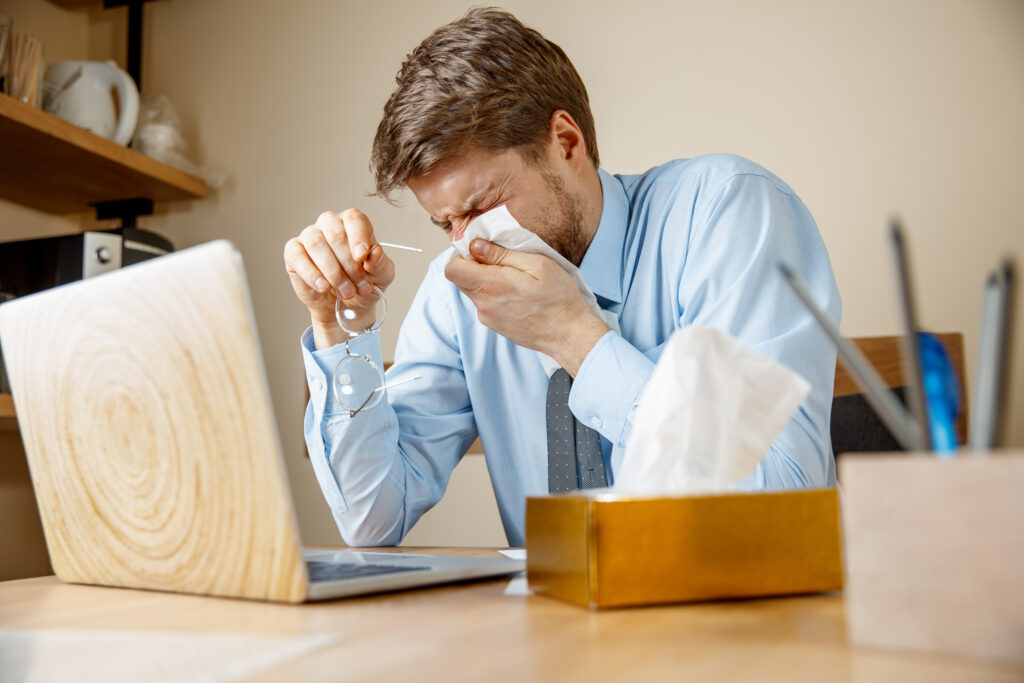According to Australasian Society of Clinical Immunology and Allergy, almost 20% of the Australian population has an allergic disease. What’s more, experts predict that by 2050, the number of Australians affected by allergic diseases could increase by 70%, reaching 7.7 million.
This fact lets us realise the growing prevalence of allergies among Australians. Years to come, millions more could be affected, potentially impacting their work and overall well-being.

Source: Freepik
Many individuals experience allergies triggered by environmental substances or particles. These allergens according to Allergy & Anaphylaxis Australia (A&AA) can induce a range of reactions, from mild to severe, and are often challenging to avoid or manage.
As autumn begins, so do a variety of allergens that can infiltrate indoor environments, especially in office and commercial spaces. Pollen from trees and plants, dust mites, and mould spores are common culprits during this season, making their way into buildings through open windows, ventilation systems, and on the clothing of employees.
Addressing workplace allergens is essential not only for the comfort and well-being of employees but also for maintaining a productive work environment. Let’s explore through this blog, how we can create healthier workplaces to mitigate these challenges and discover valuable tips for allergy prevention.
Jump to:
Understanding Autumn Allergens
1. Pollen
2. Dust mites
3. Mould spores
Health Implications
1. Allergic Rhinitis (Hay Fever)
2. Asthma
3. Sinusitis
4. Dermatitis (Eczema)
5. Reduced Productivity
Workplace Allergy Preventive Measures
Employee Education for Allergy Prevention
Expert Insights: Fighting Workplace Allergies
Conclusion
Key Takeaways
Understanding Autumn Allergens
Autumn brings a change in not just the weather, but also in the allergy shifts. As the weather cools and leaves begin to fall, certain allergens become more prevalent, leading to increased symptoms for allergy sufferers.
The autumn season in Australia introduces a set of allergens, including pollen, dust mites, and mould spores, which can significantly impact indoor spaces. Here, we’ll delve into the common culprits that can trigger allergy symptoms during this season.
1. Pollen
While spring is typically associated with an increased pollen count, some trees and weeds continue to pollinate in autumn. According to AAFA, pollen is one of the most common triggers of seasonal allergies. The White Cypress (Murray) Pine in particular, is said to be the only Australian tree that releases highly allergenic pollen, as described by Australian Society of Clinical Immunology and Allergy (ASCIA). This tree grows in regions extending from the western slopes and plains of eastern Australia to Western Australia, situated south of the Tropic of Capricorn.
Pollen, carried by the wind, finds its way indoors through open windows and doors, settling on surfaces and causing allergic reactions when inhaled.
2. Dust mites
According to research, about 10% of the world’s population is allergic to dust mites, but up to 90 percent of people with allergic asthma in some regions are sensitised to them.
Dust mites thrive in warm, humid conditions, making bedding, upholstery, and carpets their ideal breeding grounds. These microscopic creatures’ shed skin and faecal matter are potent allergens that can worsen allergy symptoms like sneezing, itchy eyes, and runny nose.
As the weather cools and heating systems kick in, homes and offices can become ideal breeding grounds for dust mites. As allergy prevention steps and to minimise their impact, it’s important to maintain indoor humidity levels below 50 percent, frequent vacuuming, and regular washing of curtains and other fabrics.
3. Mould spores
Mould spores are prevalent in damp areas such as bathrooms and basements, and can become airborne and trigger allergies when inhaled. Autumn rains can increase indoor humidity levels, creating a perfect environment for mould growth.
Understanding how these allergens enter indoor spaces is crucial for effectively managing and reducing their impact on allergy sufferers.
Health Implications

Source: Freepik
The prevalence of workplace allergens is concerning. The Allergy UK research revealed that 95% who felt allergy symptoms such as nasal problems, eye conditions, dry throats, breathing difficulties among others had experienced these in the office. What’s alarming is that over a quarter (27%) cited these symptoms as being made worse by their workplace.
Exposure to workplace allergens this autumn season can have a significant impact on your health and well-being. Here’s a closer look at the potential health risks:
1. Allergic Rhinitis (Hay Fever)
Allergic Rhinitis according to ASCIA, is very common and is caused by the nose and/or eyes coming into contact with allergens in the environment. This is the most common reaction to airborne allergens, causing symptoms like sneezing, itchy and watery eyes, runny or congested nose, and postnasal drip.
2. Asthma
Autumn allergens can exacerbate asthma symptoms, leading to increased coughing, wheezing, chest tightness, and difficulty breathing. Workplace allergens, specifically dust mites, can be particularly problematic for individuals with asthma. Dust mites are a common trigger for asthma attacks, and exposure to these allergens can result in persistent symptoms such as cough, congestion, and wheezing.
Estimates suggest that around 10 percent of the global population is allergic to dust mites. Consequently, those exposed to high levels of these allergens, the risk of developing asthma increases roughly five fold.
3. Sinusitis
Inflammation of the sinuses can occur due to allergies, causing facial pain, pressure, and congestion. Sinusitis according to ASCIA, can occur if allergic rhinitis is not treated correctly.
According to the said society, below are factors that increase the risk of developing sinusitis:
Problems with the structure of the cartilage tissue in the nose (such as a deviated septum).
- Smoking
- Nasal polyps
- Overuse of decongestant nasal sprays.
- Allergies such as allergic rhinitis, especially if untreated or poorly controlled.
4. Dermatitis (Eczema)
Common people’s responses to workplace allergens include sneezing and scratching but they could also include watery itchy eyes or eczema. Eczema according to A&AA is a long-lasting skin condition that causes intense itching. It can vary in severity, from mild patches to widespread irritation that significantly disrupts daily life.
While less common, some people experience skin irritation and inflammation upon exposure to allergens.
Reduced Productivity
Allergic reactions can significantly impact productivity in the workplace. Symptoms such as sneezing, itching, and congestion can be distracting and uncomfortable, leading to decreased focus and efficiency.
A study entitled “The Impact of Allergies and Allergy Treatment on Worker Productivity” by Wayne N. Burton, et. al, employees with allergies who reported using no medication showed a 10% decrease in productivity compared with workers without allergies.
Employers should consider implementing allergy prevention measures to reduce allergen exposure and support employees with allergies to maintain a productive work environment.
Workplace Allergy Preventive Measures
Indoor and workplace allergens encompass a variety of substances, including mould, animal saliva, pet hair and dander, cockroaches, and dust mites, among others. Additionally, smoke, exhaust, and strong chemical odours can act as irritants that trigger allergic reactions.
To reduce workplace allergens and create a healthier environment for employees, consider implementing the following practical tips:
1. Regular Cleaning
Did you know that dust settles inside the carpet more than on any other surface?
Implementing a regular cleaning schedule that prioritises removing dust and allergens is an important step for allergy prevention. This includes frequent cleaning of surfaces, carpets, and furniture.
Regular cleaning of restrooms is also crucial for preventing the buildup of mould, bacteria, and other allergens. Maintaining restroom hygiene not only reduces allergen exposure but also promotes overall cleanliness and employee well-being.
Additionally, consider hiring a commercial hygiene services provider who can ensure that restrooms are thoroughly cleaned and disinfected on a regular basis. Professional cleaners have the expertise and equipment to effectively remove allergens and maintain a high standard of cleanliness in restrooms, which is essential for a healthy work environment.
2. Enhance Air Quality with HEPA Filters
It is said that an average person spends 87% of their life indoors. If your employees mostly work indoors during working hours, the more it is important to prioritise air quality and deal with workplace allergens. Install high-efficiency particulate air (HEPA) filters in air conditioning units to trap airborne allergens and improve indoor air quality.
Use a vacuum cleaner with a HEPA filter for optimal dust capture. Vacuums with HEPA filters are great for improving indoor air quality. Don’t forget to schedule regular maintenance for ventilation systems to ensure proper air circulation and filtration.
3. Clean Workspaces
A tidy workspace is less likely to harbour allergens. According to Work Health and Safety (WHS) laws, all workers should ideally assist in spot cleaning/spills management. After all, tackling spills or any mishaps in the workplace is key to preventing dirt buildup that is harder to clean overtime.
Encourage employees to keep their personal areas clean and clutter-free to minimise dust buildup. This includes regularly wiping down desks, keyboards, and other frequently touched surfaces. Additionally, minimise unnecessary items that can collect dust, such as open containers or piles of papers.
4. Indoor Plants Policy
While indoor plants can add a touch of nature to the office, some varieties can trigger allergies due to mould or pollen. Consider implementing a policy for reducing indoor plants, especially those known to be allergenic. Opt for low-maintenance, air-purifying plants like snake plants or peace lilies and disallow plants that are known to be high sources of allergens like pollens.
5. Maintain Proper Humidity
Maintaining proper humidity levels is essential for preventing mould growth. Invest in a hygrometer to monitor humidity levels and adjust accordingly. Dehumidifiers can be helpful in areas prone to moisture buildup. By addressing excess moisture, you can create a less hospitable environment for mould spores.
Employee Education for Allergy Prevention
Empowering employees with knowledge is an important step in creating a healthier workplace for everyone. Here’s how employee education can contribute to allergy prevention:
1. Understanding Allergens
Organise training sessions or workshops to educate employees about Work Health and Safety Regulations including common workplace allergens. This will raise awareness of potential triggers like dust mites, pollen, and mould spores, and how they can impact health.
According to Occupational Health Services Australia (OHSA), monitoring of a worker’s health is legally required when the hazard has the potential to exceed exposure limits. In the context of workplace allergies, it is important to consider the workers’ health if allergen exposure has the potential to exceed safe limits.
2. Recognising Symptoms
Training should also equip employees with the ability to recognise allergic reactions in themselves and colleagues. Early identification of symptoms allows individuals to take appropriate action, such as using medication or seeking medical attention if necessary.
Most common allergy symptoms that sufferers experience are:
- Nasal Problems
- Eye Conditions
- Dry Throats
- Breathing Difficulties
- Lethargy
- Headaches
- Skin Irritations
So why are allergies and symptoms sometimes worse in the workplace?
Workplaces, especially offices, are full of hidden hazards for allergy sufferers. According to the study by Allergy UK, 90% of office workers surveyed reported that their workplace has carpeted floors.
3. Introduce Allergy Triggers
Educating employees about common allergy triggers is essential for allergy prevention in the workplace. Allergy triggers can vary widely and each employee must be aware of what can affect them.
According to Debra Fulghum Bruce, PhD of Webmd, common allergens can get trapped in tightly insulated and poorly ventilated office buildings. These can include:
- Aerosols
- Chemical fumes
- Cigarette smoke
- Cockroaches
- Cold air
- Dust
- Fresh paint
- Humid air
- Mould and mildew
- Perfume and scented products
- Pet dander
- Pollen
- Tobacco smoke and wood smoke
- Weather fronts
- Wind
4. Maintaining a Clean Environment
Educate employees on practical ways to keep their workspaces clean and organised, minimising dust and allergen build-up. This may include proper cleaning techniques, the benefits of using HEPA filters in personal air purifiers (if allowed), and responsible waste disposal practices.
Additionally, emphasise the importance of clean restrooms, as they can be breeding grounds for mould, bacteria, and other allergens. Look for restroom cleaning experts you can trust to ensure that restrooms are thoroughly cleaned and disinfected within the recommended schedules.
5. Communication and Collaboration
Encourage open communication between employees and management regarding allergies. Employees can inform supervisors of their allergies and potential triggers, while management can implement policies and procedures that benefit everyone.
6. Resources and Support
Provide employees with access to resources and support materials. This could include a list of allergy organisations, information on allergy medications, and links to websites with additional information on allergen management. By promoting these resources, you empower employees to take an active role in managing their allergies at work.
Below are some of the insightful allergy organisations in Australia where you can get more information about workplace allergens and other allergy facts:
- Australasian Society of Clinical Immunology and Allergy (ASCIA)
- Allergy & Anaphylaxis Australia (A&AA)
- The National Allergy Council
Expert Insights: Fighting Workplace Allergies

Workplace allergies can have a significant impact on productivity and employee well-being. Doctors’ research from the 1Department of Allergology, Spain reveals that about 1 in 10 workers suffer from allergic rhinitis (AR), a condition that can lead to symptoms such as sneezing, nasal congestion, and itchy eyes.
It was also found out that allergies can significantly impact productivity, with studies showing decreased performance in individuals with moderate to severe allergic rhinitis (hay fever). Symptoms like sneezing, congestion, and itchy eyes can disrupt focus and concentration, leading to lost work time and decreased output.
While dust mites and pollen are often the first culprits that come to mind, occupational allergies can be triggered by a wider range of substances. As 2Dr. Kari Reijula highlights in his study with his colleagues, over 250 agents can cause allergic reactions through inhalation or skin contact. This risk is particularly high in certain professions like animal handling, baking, and textile work.
Additionally, research by 3Dr. Pham et al., 2023 from the Department of Allergy and Clinical Immunology, Vietnam, suggests a link between exposure to environmental allergens and asthma severity. This emphasises the importance of comprehensive allergen management in the workplace, more than just focusing on common triggers. By taking a holistic approach and considering potential allergens specific to different industries, businesses can create a safer and healthier work environment for everyone.
Maintaining a clean work environment is crucial to minimise allergens like dust mites, pollen, and mould spores that trigger these reactions. By implementing regular cleaning protocols and investing in air purification systems, businesses can create a healthier and more productive environment for all employees.
Conclusion
Combating workplace allergens in this autumn season is essential not only for employee comfort but also for maintaining a productive work environment. By understanding common allergens and implementing preventative measures, businesses can create a healthier and happier work environment for everyone.
Key Takeaways
- Exposure to various allergens can trigger a variety of health problems, including allergic rhinitis, asthma, sinusitis, and dermatitis.
- Open communication and collaboration between employees and management are essential for effective allergy prevention in the workplace.
- Autumn brings a surge in allergens like pollen, dust mites, and mould spores, impacting indoor spaces. Restrooms, due to their damp environment, are common breeding grounds for mould spores, which can significantly worsen allergies.
- Employers should take proactive steps to minimise allergens like regular cleaning, using HEPA filters, maintaining proper humidity, and educating employees. An important tip is to consider hiring a professional restroom hygiene service provider to ensure thorough cleaning and disinfection to minimise mould growth and other allergens in restrooms.
Impact Hygiene offers comprehensive restroom hygiene services, antibacterial germicide misting and disinfection, to help reduce allergens and create a healthier environment for employees and customers. Our expert technicians are trained to identify and address potential allergen sources, ensuring that your restroom meets the highest hygiene standards.
Contact us today to learn more about how we can help improve the air quality in your workplace! 1800 494 369 | www.impacthygiene.com.au/contact-us.
Check out more of our services here.
References:
1Caballer, et al., 2012, “Allergic rhinitis and its impact on work productivity in primary care practice and a comparison with other common diseases: The Cross-sectional study to evAluate work Productivity in allergic Rhinitis compared with other common dIseases (CAPRI) study” (Research), 2012 Sep-Oct, https://www.ncbi.nlm.nih.gov/pmc/articles/PMC3904041/
2Reijula, et al., 2007, “Controlling Occupational Allergies in the Workplace” (Research), Feb-2007, https://www.researchgate.net/publication/6199257_Controlling_Occupational_Allergies_in_the_Workplace
3Dr. Pham et al., 2023, “Environmental allergen reduction in asthma management: an overview” (Research), https://www.ncbi.nlm.nih.gov/pmc/articles/PMC10587592/







